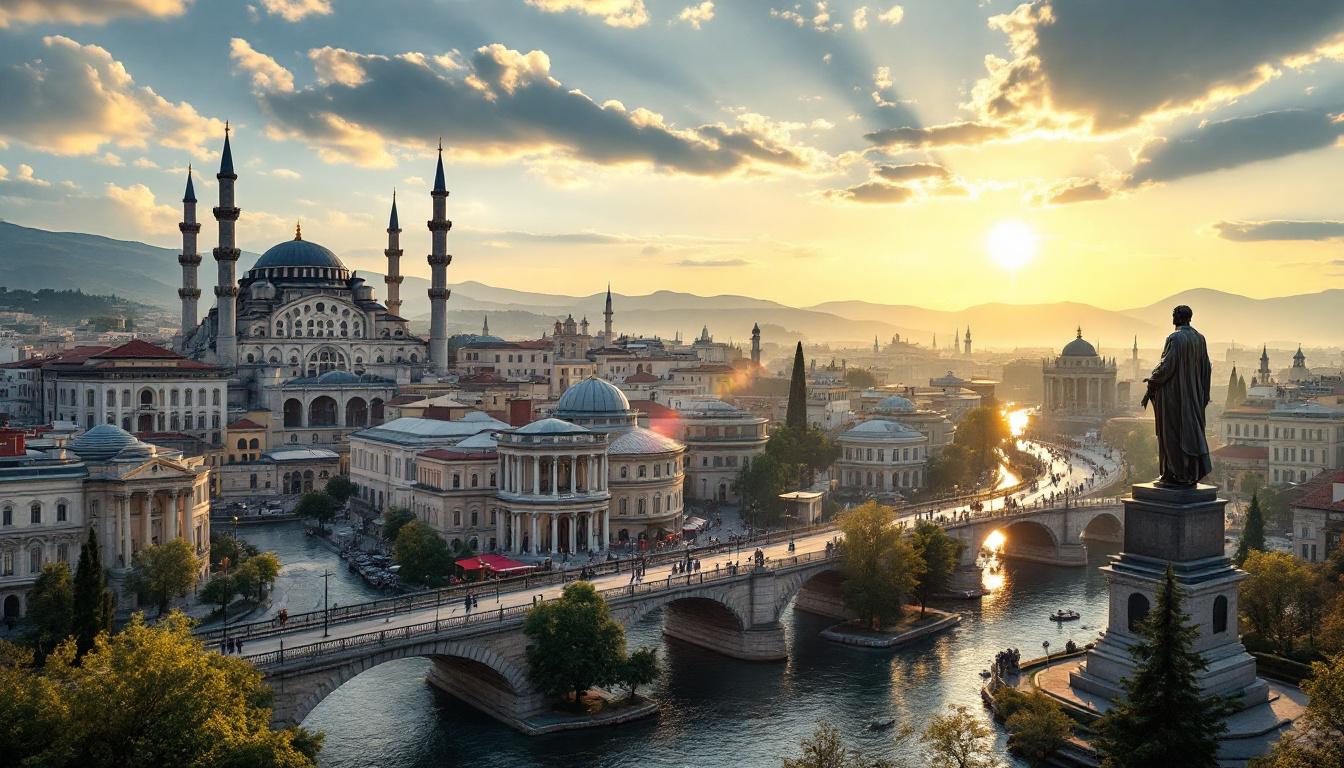Skopje’s dual personality hits you immediately – ancient Ottoman minarets piercing the sky above a sea of controversial neoclassical buildings and larger-than-life statues. This capital of North Macedonia might be Europe’s most architecturally eccentric city, where centuries of history collide with a bold national identity experiment.
A city reinventing itself through controversial architecture
Following a devastating 1963 earthquake that destroyed 80% of the city, Skopje underwent massive reconstruction. But it’s the “Skopje 2014” project that truly transformed the capital, adding hundreds of statues, fountains, and neoclassical facades in an ambitious (and divisive) attempt to reclaim national heritage after Yugoslavia’s collapse.
“Our city has always been at a crossroads of empires – Ottoman, Byzantine, Yugoslav – and now we’re writing our own architectural story, for better or worse,” explains Marko, a local architect who leads walking tours through the city center.
The Old Bazaar: Where authentic Ottoman spirit survives
Cross the 15th-century Stone Bridge spanning the Vardar River, and you’ll discover Skopje’s true historical heart – the Old Bazaar (Čaršija). Unlike the manufactured grandeur downtown, these cobblestone streets host the Balkans’ second-largest Ottoman bazaar outside Istanbul. Coppersmiths hammer traditional djezves (coffee pots) using centuries-old techniques as spice vendors call out their wares.
Europe’s most affordable capital city
Budget travelers rejoice – Skopje ranks as Europe’s least expensive capital. Gourmet meals with local wine rarely exceed $15, while centrally-located boutique hotels average $50 nightly. Taxis start at under $1, making even far-flung attractions accessible without breaking the bank.
Matka Canyon: Mediterranean fjords 30 minutes from downtown
Just beyond city limits lies Matka Canyon, where emerald waters wind between dramatic limestone cliffs. Rent a kayak ($8/hour) to explore this unexpected wilderness, stopping at cave monasteries that feel worlds away from urban Skopje. The otherworldly beauty rivals more famous natural wonders but without the crowds.
The city of a thousand statues
Nowhere is Skopje’s personality crisis more evident than Macedonia Square, dominated by a 72-foot-tall Alexander the Great monument. Dozens more bronze figures populate every available space – from mythological heroes to shoe-shiners frozen mid-polish. This statuary extravaganza makes Skopje feel like an open-air museum, albeit one designed by a committee with unlimited bronze and ambition.
Mother Teresa’s birthplace and memorial
Few realize the humble nun who won the Nobel Peace Prize was born in Skopje in 1910. The Mother Teresa Memorial House stands where her family home once existed, offering insight into her early years through personal artifacts and photographs. It’s a serene contrast to the bombastic architecture nearby.
“Teresa may have left Skopje as a teenager, but her spirit of compassion represents the true character of our people better than any giant statue,” shares Emilija, the memorial’s curator.
Mount Vodno and the Millennium Cross
Overlooking the city, the world’s fourth-largest cross (216 feet tall) crowns Mount Vodno. Accessible via cable car, this vantage point reveals Skopje’s fascinating urban sprawl nestled between mountain ranges. The panorama rivals views from medieval fortress lookouts elsewhere in Europe.
Culinary surprises beyond Balkan standards
While traditional taverns (kafanas) serve hearty staples like tavče gravče (baked beans) and ajvar (roasted red pepper spread), Skopje’s food scene extends beyond expected fare. The Old Bazaar houses artisanal eateries blending Ottoman, Mediterranean and Slavic influences in surprising combinations.
When to visit: shoulder seasons shine
Avoid sweltering Balkan summers and opt for May-June or September-October when temperatures hover around 75°F. These periods offer perfect conditions for exploring both urban attractions and natural sites like nearby lakes and mountains.
Skopje defies easy categorization – simultaneously ancient and brand new, authentic and artificial, frustrating and captivating. It’s a city comfortable with contradictions, offering visitors an architectural fever dream backed by genuine Balkan hospitality and surprising affordability. In a continent full of carefully preserved historic centers, Skopje’s unapologetic reinvention stands as Europe’s most audacious urban experiment.
